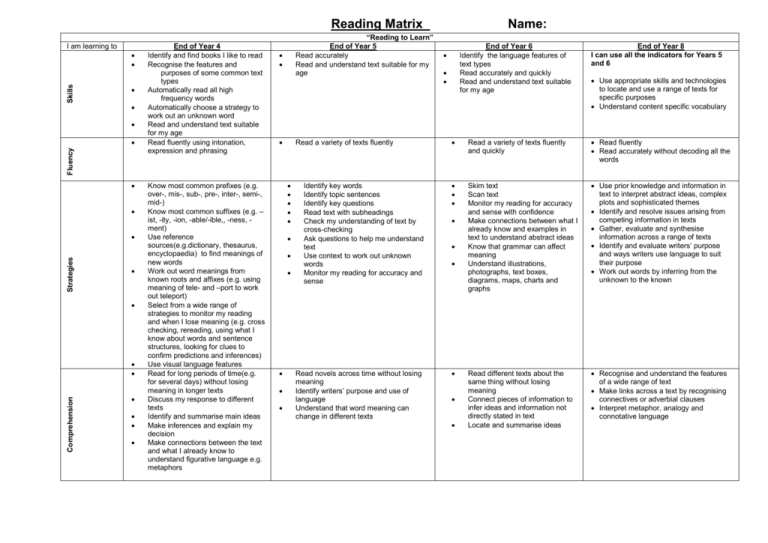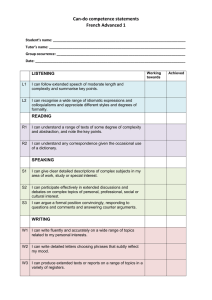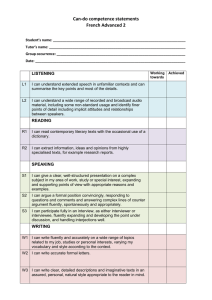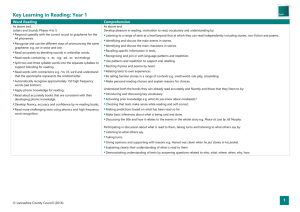Reading matrix Year 4 to 8 on one sheet
advertisement

Reading Matrix I am learning to Skills Fluency Strategies Comprehension End of Year 4 Identify and find books I like to read Recognise the features and purposes of some common text types Automatically read all high frequency words Automatically choose a strategy to work out an unknown word Read and understand text suitable for my age Read fluently using intonation, expression and phrasing Know most common prefixes (e.g. over-, mis-, sub-, pre-, inter-, semi-, mid-) Know most common suffixes (e.g. – ist, -ity, -ion, -able/-ible,, -ness, ment) Use reference sources(e.g.dictionary, thesaurus, encyclopaedia) to find meanings of new words Work out word meanings from known roots and affixes (e.g. using meaning of tele- and –port to work out teleport) Select from a wide range of strategies to monitor my reading and when I lose meaning (e.g. cross checking, rereading, using what I know about words and sentence structures, looking for clues to confirm predictions and inferences) Use visual language features Read for long periods of time(e.g. for several days) without losing meaning in longer texts Discuss my response to different texts Identify and summarise main ideas Make inferences and explain my decision Make connections between the text and what I already know to understand figurative language e.g. metaphors “Reading to Learn” End of Year 5 Read accurately Read and understand text suitable for my age End of Year 6 Identify the language features of text types Read accurately and quickly Read and understand text suitable for my age End of Year 8 I can use all the indicators for Years 5 and 6 Use appropriate skills and technologies to locate and use a range of texts for specific purposes Understand content specific vocabulary Read a variety of texts fluently and quickly Read fluently Read accurately without decoding all the words Identify key words Identify topic sentences Identify key questions Read text with subheadings Check my understanding of text by cross-checking Ask questions to help me understand text Use context to work out unknown words Monitor my reading for accuracy and sense Skim text Scan text Monitor my reading for accuracy and sense with confidence Make connections between what I already know and examples in text to understand abstract ideas Know that grammar can affect meaning Understand illustrations, photographs, text boxes, diagrams, maps, charts and graphs Use prior knowledge and information in text to interpret abstract ideas, complex plots and sophisticated themes Identify and resolve issues arising from competing information in texts Gather, evaluate and synthesise information across a range of texts Identify and evaluate writers’ purpose and ways writers use language to suit their purpose Work out words by inferring from the unknown to the known Read novels across time without losing meaning Identify writers’ purpose and use of language Understand that word meaning can change in different texts Read different texts about the same thing without losing meaning Connect pieces of information to infer ideas and information not directly stated in text Locate and summarise ideas Recognise and understand the features of a wide range of text Make links across a text by recognising connectives or adverbial clauses Interpret metaphor, analogy and connotative language Read a variety of texts fluently Name:











